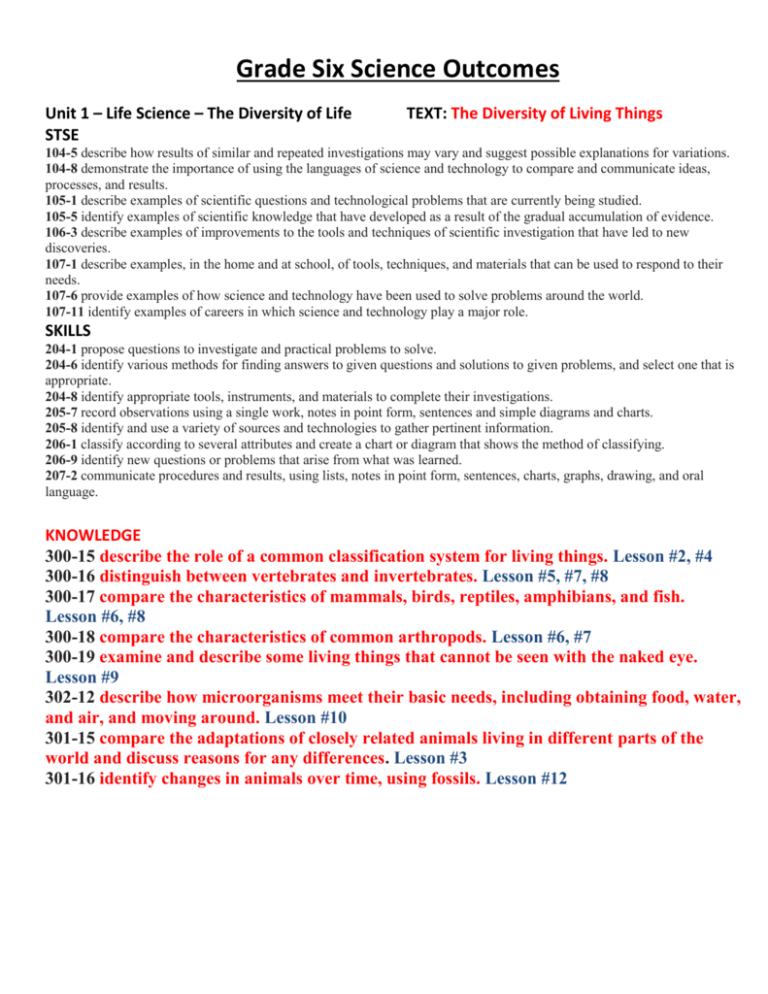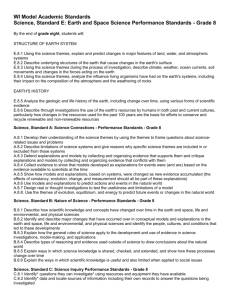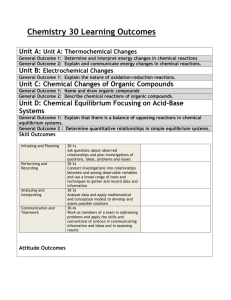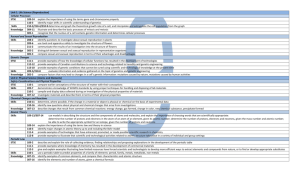Grade Six Science Outcomes Unit 1 – Life Science – The Diversity of
advertisement

Grade Six Science Outcomes Unit 1 – Life Science – The Diversity of Life STSE TEXT: The Diversity of Living Things 104-5 describe how results of similar and repeated investigations may vary and suggest possible explanations for variations. 104-8 demonstrate the importance of using the languages of science and technology to compare and communicate ideas, processes, and results. 105-1 describe examples of scientific questions and technological problems that are currently being studied. 105-5 identify examples of scientific knowledge that have developed as a result of the gradual accumulation of evidence. 106-3 describe examples of improvements to the tools and techniques of scientific investigation that have led to new discoveries. 107-1 describe examples, in the home and at school, of tools, techniques, and materials that can be used to respond to their needs. 107-6 provide examples of how science and technology have been used to solve problems around the world. 107-11 identify examples of careers in which science and technology play a major role. SKILLS 204-1 propose questions to investigate and practical problems to solve. 204-6 identify various methods for finding answers to given questions and solutions to given problems, and select one that is appropriate. 204-8 identify appropriate tools, instruments, and materials to complete their investigations. 205-7 record observations using a single work, notes in point form, sentences and simple diagrams and charts. 205-8 identify and use a variety of sources and technologies to gather pertinent information. 206-1 classify according to several attributes and create a chart or diagram that shows the method of classifying. 206-9 identify new questions or problems that arise from what was learned. 207-2 communicate procedures and results, using lists, notes in point form, sentences, charts, graphs, drawing, and oral language. KNOWLEDGE 300-15 describe the role of a common classification system for living things. Lesson #2, #4 300-16 distinguish between vertebrates and invertebrates. Lesson #5, #7, #8 300-17 compare the characteristics of mammals, birds, reptiles, amphibians, and fish. Lesson #6, #8 300-18 compare the characteristics of common arthropods. Lesson #6, #7 300-19 examine and describe some living things that cannot be seen with the naked eye. Lesson #9 302-12 describe how microorganisms meet their basic needs, including obtaining food, water, and air, and moving around. Lesson #10 301-15 compare the adaptations of closely related animals living in different parts of the world and discuss reasons for any differences. Lesson #3 301-16 identify changes in animals over time, using fossils. Lesson #12 Unit 2 – Physical Science – Electricity STSE TEXT: Turn It On 104-5 describe how results of similar and repeated investigations may vary and suggest possible explanations for variations. 105-3 describe examples of scientific questions and technological problems that have been addressed differently at different times. 106-3 describe examples of improvements to the tools and techniques of scientific investigation that have led to new discoveries. 106-4 describe instances where scientific ideas and discoveries have led to new inventions and applications. 107-9 compare past and current needs, and describe some ways in which science and technology have changed the way people work, live, and interact with the environment. 108-5 describe how personal actions help conserve natural resources and protect the environment in their region. 108-8 describe the potential impact of the use by humans of regional natural resources. SKILLS 204-1 propose questions to investigate and practical problems to solve. 204-3 state a prediction and a hypothesis based on an observed pattern of events. 204-4 define objects and events in their investigations 204-7 plan a set of steps to solve a practical problem and to carry out a fair test of a science-related idea. 204-8 identify appropriate tools, instruments, and materials to complete their investigations. 205-1 carry out procedures to explore a given problem and to ensure a fair test of a proposed idea, controlling major variables. 205-3 follow a given set of procedures. 205-7 record observations using a single word, notes in point form, sentences, and simple diagrams and charts. 205-9 use tools and apparatus in a manner that ensures personal safety and the safety of others. 206-3 identify and suggest explanations for patterns and discrepancies in data. 207-2 communicate procedures and results, using lists, notes in point form, sentences, charts, graphs, drawings, and oral language. KNOWLEDGE 303-31 identify and explain the dangers of electricity at work or at play. Lesson #2 303-23 compare a variety of electrical pathways by constructing simple circuits. Lesson #4, #5, #6 300-20 compare the conductivity of a variety of solids and liquids. Lesson #5 303-24 describe the role of switches in electrical circuits. Lesson #6 303-25 compare characteristics of series and parallel circuits. Lesson #6 303-22 compare the characteristics of static and current electricity. Lesson #3, #4 303-27 describe the relationship between electricity and magnetism when using an electromagnet. Lesson #7 303-26 demonstrate how electricity in circuits can produce light, heat, sound, motion, and magnetic effects. Lesson #11 303-28 identify various methods by which electricity can be generated. Lesson #8, #9 303-29 identify and explain sources of electricity as renewable or nonrenewable. Lesson #9 303-30 identify and explain different factors that could lead to a decrease in electrical energy consumption in the home and at school. Lesson #2, #10 Unit 3 – Physical Science – Flight STSE TEXT: The Sky’s The Limit 104-3 demonstrate and explain the importance of selecting appropriate processes for investigating scientific questions and solving technological problems. 104-5 describe how results of similar and repeated investigations may vary and suggest possible explanations for variations. 105-3 describe examples of scientific questions and technological problems that have been addressed differently at different times. 106-3 describe examples of improvements to the tools and techniques of scientific investigation that have led to new discoveries. 106-4 describe instances where scientific ideas and discoveries have led to new inventions and applications. 107-6 provide examples of how science and technology have been used to solve problems around the world 107-9 compare past and current needs, and describe some ways in which science and technology have changed the way people work, live, and interact with the environment. 107-12 provide examples of Canadians who have contributed to science and technology. SKILLS 204-2 rephrase questions in a testable form. 204-7 plan a set of steps to solve a practical problem and to carry out a fair test of a science-related idea. 205-1 carry out procedures to explore a given problem and to ensure a fair test of a proposed idea, controlling major variables. 205-2 select and use tools in manipulating materials and in building models. 205-5 make observations and collect information that is relevant to a given question or problem. 205-8 identify and use a variety of sources and technologies to gather pertinent information. 206-6 suggest improvements to a design or constructed object 207-2 communicate procedures and results, using lists, notes in point form, sentences, charts, graphs, drawings, and oral Language. KNOWLEDGE 301-18 describe and demonstrate methods for altering drag in flying devices. Lesson #6, #9, #10 303-32 describe the role of lift in overcoming gravity and enabling devices or living things to fly. Lesson #6 301-17 describe and demonstrate how lift is affected by the shape of a surface. Lesson #6 300-21 identify characteristics and adaptations that enable birds and insects to fly. Lesson #11 303-33 identify situations which involve Bernoulli’s principle. Lesson #5, #6, #8 303-34 describe the means of propulsion for flying devices. Lesson #3, #7, #8 300-22 describe and justify the differences in design between aircraft and spacecraft. Lesson #3, #8B Unit 4 – Earth and Space Science – Space STSE TEXT: Out of This World 104-8 demonstrate the importance of using the languages of science and technology to compare and communicate ideas, processes, and results. 105-1 identify examples of scientific questions and technological problems that are currently being studied. 105-6 describe how evidence must be continually questioned in order to validate scientific knowledge. 106-3 describe examples of improvements to the tools and techniques of scientific investigation that have led to new discoveries. 107-3 compare tools, techniques, and scientific ideas used by different people around the world to interpret natural phenomena and meet their needs. 107-12 provide examples of Canadians who have contributed to science and technology. 107-15 describe scientific and technological achievements that are the result of contributions by people from around the world. SKILLS 204-6 identify various methods for finding answers to given questions and solutions to given problems, and select one that is appropriate. 205-2 select and use tools in manipulating materials and in building models. 205-8 identify and use a variety of sources and technologies to gather pertinent information. 206-4 evaluate the usefulness of different information sources in answering a given question. 207-2 communicate procedures and results, using lists, notes in point form, sentences, charts, graphs, drawings, and oral Language. KNOWLEDGE 301-21 describe how astronauts are able to meet their basic needs in space. Lesson #12, #13 301-19 demonstrate how Earth’s rotation causes the day and night cycle and how Earth’s revolution causes the yearly cycle of seasons. Lesson #5 301-20 observe and explain how the relative positions of Earth, the moon, and the sun are responsible for the moon phases, eclipses, and tides. Lesson #6, #7, #8 300-23 describe the physical characteristics of components of the solar system—specifically, the sun, planets, moons, comets, asteroids, and meteors. Lesson #2, #3, #4 302-13 identify constellations in the night sky. Lesson #9








